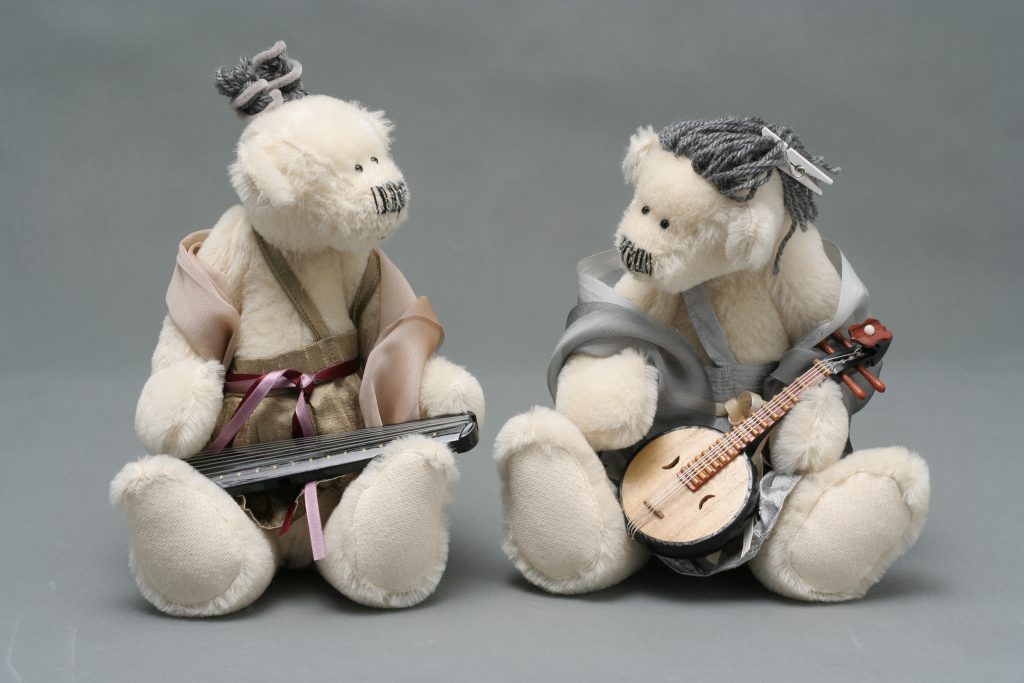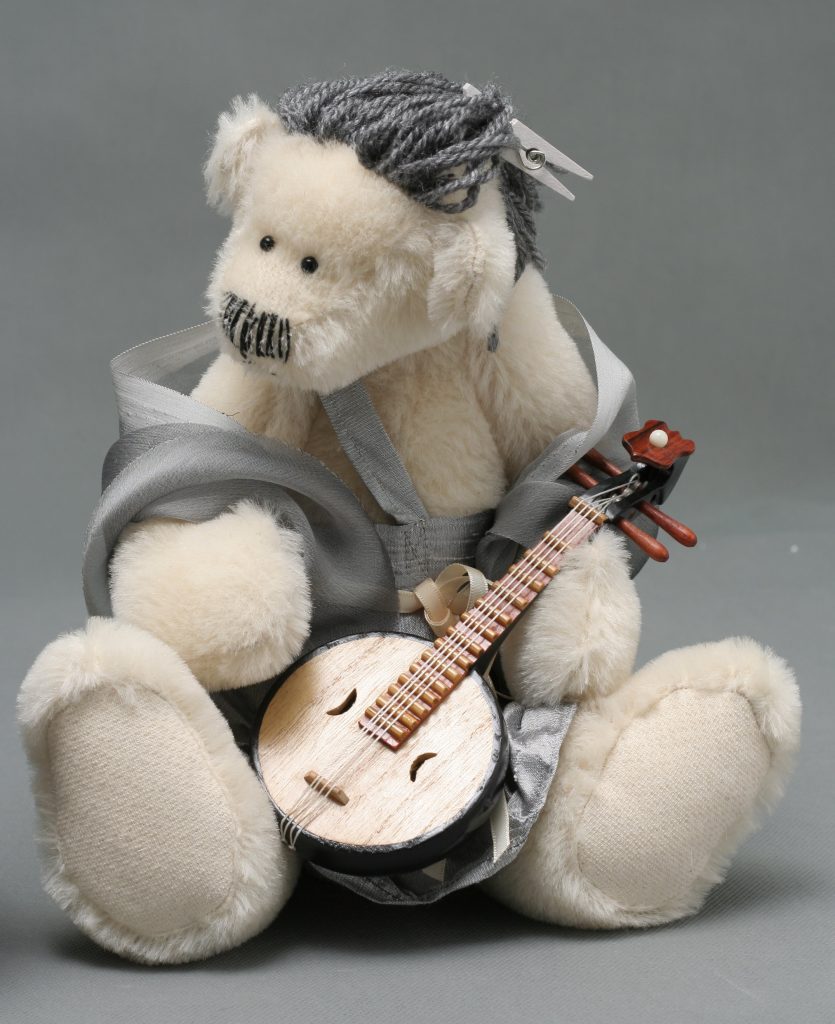Here we introduce two more figures in The Teddy Bear Chronicles 縫熊誌, created by the Hong Kong writer and teddy bear artist Xi Xi 西西, and translated by Christina Sanderson.
The teddies and essay below feature Xi Kang 嵇康 and Ruan Xian 阮咸, two of the famed Seven Sages of the Bamboo Grove 竹林七賢. This informal group of free-wheeling individuals flourished during the early decades of the Six Dynasties period (third to sixth centuries CE). That era is also a feature of our inaugural China Heritage Annual, which takes Nanking as its focus.
Xi Kang is also one of the guiding spirits of China Heritage; his personality and words inspired On Heritage 遺, an essay that offers a Rationale for The Wairarapa Academy for New Sinology.
One of our China Heritage projects is to introduce Xi Xi’s Chronicles in translation and we are grateful to Christina for continuing to share her work with our readers, and to John Minford who introduced us all to Xi Xi’s panoply of bears. The full translation of The Teddy Bear Chronicles will appear as a volume in a series under John’s editorship. That series is generously funded by the Hong Kong Arts Development Council.
— Geremie R. Barmé, Editor, China Heritage
The seven used to gather beneath a bamboo grove, letting their fancy free in merry revelry. For this reason the world called them the Seven Sages of the Bamboo Grove 七人常集於竹林之下,肆意酣暢,故世謂竹林七賢。
— Liu Yiqing (劉義慶, 403-444CE),
New Sayings of the World 世說新語,
trans. Richard B. Mather
Ji Kang 稽康 (zi 叔夜), A.D. 223-262. A native of modern Anhui. his ancestors came from Zhejiang, whence they had fled in consequence of political disturbances, changing the family name from 奚 Xi to Ji. As a youth, he was clever and handsome, and seven feet seven inches in height. Yet he is said to have regarded his body as so much clay or wood, and refused to adorn it. He married into the Imperial family, and received and official appointment. But his favourite study was alchemistic research: and he passed his days sitting under a willow-tree in his court-yard and experimenting in the transmutation of metals, varying his toil with music and poetry, and practising the art of breathing with a view to securing immortality. Happening however to offend by his want of ceremony one of the Imperial princes, who was also a student of alchemy, he was denounced to the Emperor Wen of the Wei dynasty [sic, actually the Jin — C.S.] as a dangerous person and a traitor, and condemned to death. Three thousand disciples offered each one to take the place of their beloved master, but their request was not granted. He met his fate with fortitude, calmly watching the shadows thrown by the sun and playing upon his lute.
— ‘Chi K’ang’ in Herbert Giles, A Chinese Biographical Dictionary,
Shanghai, 1898, pp.119-120, with modified romanisation
Xi Kang and Ruan Xian of the Six Dynasties
Xi Xi
Translated by Christina Sanderson
Passing a music shop one day, I saw a display of several miniature musical instruments. I went in and chose two, and then went home to make teddies of some of the Seven Sages of the Bamboo Grove. 經過樂器店的飾櫥,見到窗櫥內陳列了幾件微型樂器,進去選了兩件,回家縫竹林人物。

Xi Kang played a seven-stringed zither 琴. The body of the instrument has a wide end called the head and a narrow end called the tail. Along the side of the finger board are thirteen small white dots 徽, which mark different notes in the scale. The finest quality ones are made of jade, and the best strings are made of silk. When he was faced with imminent execution, Xi Kang played a tune on his zither called the ‘Melody of Guangling’, Guangling San 廣陵散. ‘San’ 散 is the name of this type of free melody; Guangling was a place in the present-day city of Yangzhou in Jiangsu province. The music tells the tragic tale of vengeance of Nie Zhen, who assassinated Xia Lei, the Prime Minister of the small state of Han, during the Warring States period. 嵇康彈的是七弦古琴,一般有七弦。琴身頭寬尾窄,面板外側有十三粒小白圓點,稱徽,是音階的標誌。第一等的徽用玉製,弦用蠶絲。嵇康在臨刑時彈《廣陵散》。散是曲名,廣陵是地名,即今江蘇揚州。樂曲是復仇者的頌歌,敘述戰國時聶政刺殺韓相俠累的悲劇。
During the Wei-Jin period, distinguished men of letters 名士 dressed unconventionally. They enjoyed taking their clothes off. Men wore skirts just like women and tied their hair up. Xi Kang is wearing a special sort of skirt featuring a shoulder strap. His hair is done up in a top-knot, which I fashioned according to one of the clay brick impressions of the Seven Sages of the Bamboo Grove found near Nanjing. I think the zither in the brick impression is the wrong way around. Perhaps it was deliberately sketched that way when it was being carved so that Xi Kang could sit facing Ruan Ji. 魏晉名士衣飾不落俗套,喜坦膚裸體,男子也著裙,梳了角髻。嵇康穿攀帶裙。頭紮卯髻,我讓髮式依循漢磚壁畫《竹林七賢》的圖照。畫中的古琴我想擺錯了方向,不知是否刻蝕時圖稿故意反轉了,要配合和阮步兵相向而坐?

Ruan Xian is playing a plucked string instrument with a long neck. These are normally called ‘moon lutes’ 月琴 after the round shape of the body. Since Ruan played one, they are sometimes called ruan after him. It was the precursor of the more famous, upright lute-like instrument called the pipa 琵琶. Ruan’s moon lute had twelve frets and he used a bamboo plectrum to pluck the strings. 阮咸撥的是圓月形有長項的琴,一般叫月琴,因為阮咸奏過,琴以人傳,稱阮咸。它是琵琶的前身。阮咸的阮有回弦十二柱,他用竹片撥。

I had his hair loose, but it hung down over his face. So I just clamped it back with a peg, which looks very post-modern. Like Xi Kang, he’s wearing a skirt with a shoulder strap, too. They are both wearing a special kind of decorative shawl. 我讓阮咸披髮,額前髮絲會垂掛遮面,就用個晾衣夾咬住,十分後現代。和嵇康相同,他也著攀帶長裙。二人都披一幅特別的巾帔。
There are two famous paintings, Northern Qi Scholars Collating Classic Texts and Gentlemen in Retirement which feature groups of literati, all wearing skirts with shoulder straps and semi-circular chiffon shawls extending down below the waist. The shawl is draped around the back of Ruan’s shoulders, with the ends hanging in front of his chest. There is a pair of silk ribbons which can be used to tie the ends of the shawl together. It really is a very beautiful garment. It’s like the silken head scarf worn by the wizard and master strategist Zhuge Liang who was known to carry a fan made from crane feathers. After all, who’s to say head scarves have to be worn on the head? 《北齊校書圖》和《高逸圖》中有一群文士,個個穿吊帶裙,身披一幅半圓形垂到腰以下透明的紗羅披肩。披巾搭繞在肩背上,兩隻角垂在胸前,兩襟綴有一對帛帶,可繫結住巾角。這件衣物真是漂亮出眾,可能就是羽扇綸巾的巾。誰說綸巾一定是紮在頭上的呢。半個輪形的巾可不就是綸巾。輪、綸相通。


